Melons grow best when summers are hot, dry, and almost always sunny. The best-flavored melons will come from the hottest-growing regions. Both cloudy and rainy weather will slow and all but stop melon growth.
Melons grow best when both the soil and air temperature are at least 70°F (21°C). You can sow seeds directly in the ground two or more weeks after the last frost. Expect germination in 3 to 10 days, depending on the soil temperature. (The higher the temperature the faster the seed will sprout.)
Related articles:
- Tasty Ways to Serve Melons
- Melons Seed Starting Tips
- How to Plant and Grow Melons
- How to Plant and Grow Watermelon
- How to Harvest and Store Melons
- Melons Growing Problems Troubleshooting
Melons need sustained soil and air temperatures of 70°F (21°C) or greater for 75 to 100 days for the best and most flavorful growth. Plant seeds in the garden as soon as the soil is warm and dry to give these melons the greatest number of hot days. Get a head start on the season by starting plants from seed indoors, 2 to 3 weeks before the last frost, then transplant seedlings to the garden no sooner than 2 weeks after the last frost.
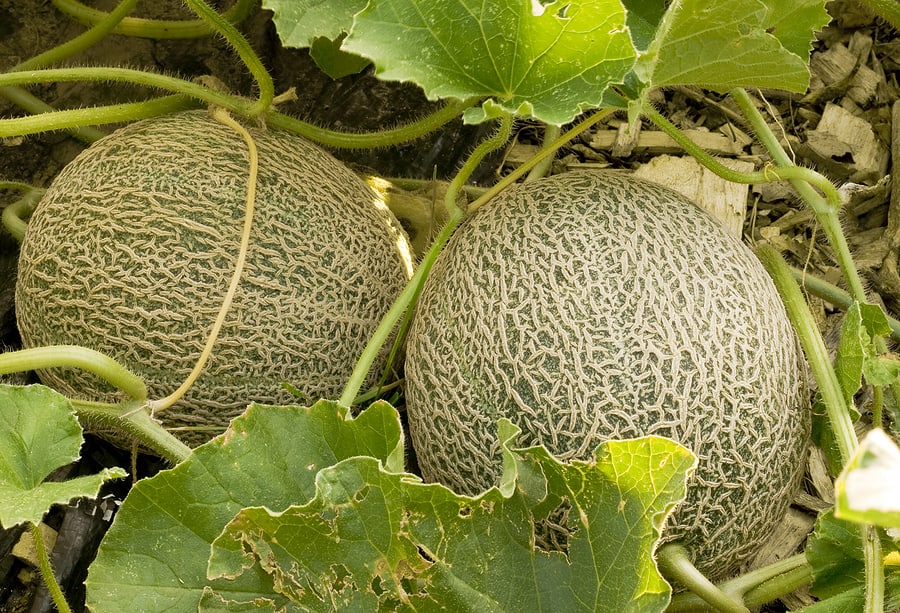
The melons are tender, warm-weather plants. Melons grow best in very warm to hot weather summer regions. Melons are long, trailing annuals that belong to the cucumber and watermelon family.
The netted melon or muskmelon is commonly called a cantaloupe, but should not be confused with the real cantaloupe, which is a warty rock melon. Another type of melon that is often grown in the summer garden is honeydew. It along with the casaba, Crenshaw, and Persian melon are often referred to as winter melons. They are called winter melons because they ripen later and require a long growing season than muskmelons.
The growing information for muskmelons, cantaloupes, honeydew, and other winter melons is the same.
Garden Planning Books at Amazon:
- Vegetable Garden Almanac & Planner
- Kitchen Garden Grower’s Guide Vegetable Encyclopedia
- Vegetable Garden Grower’s Guide
- Tomato Grower’s Answer Book
Here is your complete guide to growing melons.
Summer melons and winter melons
- Muskmelons along with watermelons are termed summer melons because they come to harvest from mid to late summer.
- Winter melons—which are grown during the summer like muskmelons–are ready for harvest in late summer and autumn. Winter melons include casaba, Crenshaw, honeydews, and Persian melons.
- Cantaloupes, muskmelons, honeydew melons, and other summer melons, as well as winter melons, have the same growing requirements.
- Cantaloupes, muskmelons, honeydew melons, and other summer melons, as well as winter melons, have the same growing requirements.
- Winter melons require 110 frost-free days to reach harvest, more days than required by the summer melons, cantaloupe or muskmelon, and watermelon.
Melon quick-growing tips
- All melons require a growing season of at least 100 frost-free days. Plant melons when the soil has warmed to 70° to 80°F. To jump-start the season start seeds indoors 2 to 4 weeks before transplanting them into the garden.
- Sow cantaloupe (muskmelon) seed in the garden or set out transplants 3 to 4 weeks after the last average frost date in spring.
- Start cantaloupe seed indoors 6 weeks before transplanting seedlings into the garden. Start seed indoors in biodegradable peat or paper pots that can be set directly into the garden.
- Cantaloupes require 70 to 100 frost-free days to reach harvest; cantaloupes will tolerate no frost.
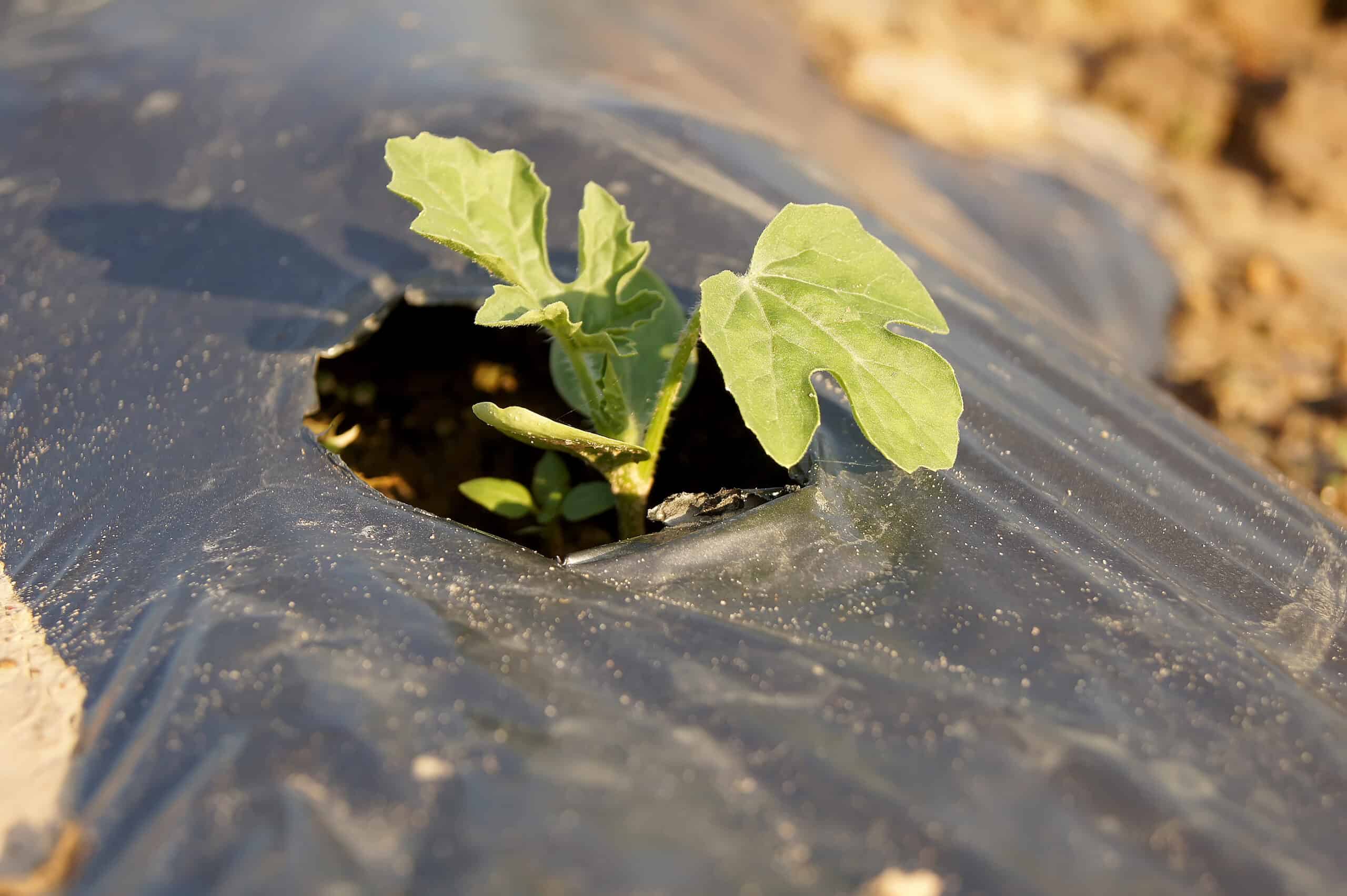
Where to plant melons
Grow melons in full sun with plenty of air circulation. Melons must stay warm and dry to prevent disease and grow quickly and uninterrupted. Grow melons in loose, well-drained soil rich in organic matter. Prepare planting beds with aged compost and side dress with compost during the growing season. Grow melons on raised hills: 4 to 6 feet apart for muskmelons, 6 to 12 feet apart for watermelons. Thin to 2 to 3 melons per hill or fewer.
Grow melons in raised beds or on hills or mounds that warm early in the season. In late spring, about the time of the last expected frost, dig holes about 18 inches deep and wide. Throw a handful of bone meal or all-purpose vegetable fertilizer (or half a shovelful of aged steer manure) into the bottom of each hole then backfill with a mix of aged compost, sand, and native garden soil or a half-and-half mix of store-bought planting mix and native soil.
If you are not planting in a raised bed, top each hole with the same mix to form a mound about six inches high and a foot or two wide. Water in the soil and cover the bed or mound with black plastic sheeting (plastic mulch) or black landscape fabric that will absorb solar heat. Let the soil warm up for 10 days or more before sowing or transplanting.
- Plant melons in full sun.
- Melons grow best in loose, well-drained, loamy soil rich in organic matter.
- Add several inches of aged compost and aged manure or commercial organic planting mix to the planting bed before planting. Turn the soil to 12 inches (30cm) deep.
- Melons prefer a soil pH of 6.0 to 6.8.
- Melons can be grown on mounds, raised beds, up trellises, or in flat planting beds. Pre-warm the soil by placing black plastic or permeable black garden fabric across the planting area two weeks before planting. When planting cut x-shaped slits in the covering.
Melon planting time
Give melons a long growing season; a long, hot growing season will increase flavor and yield.
Plant seeds in the garden as soon as the soil is warm and dry to give these crops the greatest number of hot days. Get a head start on the season by starting plants from seed indoors, 2 to 3 weeks before the last frost, then transplant seedlings to the garden no sooner than 2 weeks after the last frost.
- Sow melon seeds in the garden or set out transplants 3 to 4 weeks after the last average frost date in spring.
- Start melon seeds indoors about 6 weeks before transplanting seedlings into the garden.
- Start seeds in biodegradable peat or paper pots at least 4 inches in diameter that can be set wholly into the garden so as not to disturb roots.
- Starting melons indoors is recommended in short-growing season regions where the soil warms slowly in spring.
- Melon seeds will germinate in about 10 days at 65°F (18°C).
- Melons grow best in air temperatures ranging from 70° to 90°F (21-32°C).
- If temperatures exceed 90°F (32°C)
- for several days, flowers will drop without setting fruit.
- Melons require 70 to 100 frost-free days to reach harvest and will tolerate no frost.
- In cool or short-season regions, grow smaller varieties that come to harvest the quickest.
More tips: Melon Seed Starting Tips.
Pre-warm the soil for melons
Warming the soil ahead of planting melons will give seeds and seedlings a strong start. Pre-warm the soil by placing black plastic sheeting across the planting area to harvest solar heat. Draw the plastic tight so that there is little air space between the plastic and the soil.
Once the soil has warmed and plants are growing, the black plastic mulch can be removed and replaced with an organic mulch of dried leaves, straw, hay, or dried grass clippings. (Don’t use fresh or wet grass clippings; they will mildew.) Mulch will keep down weeds, slow soil moisture evaporation, and slowly decompose adding nutrients to the soil. Make sure the organic mulch you use is pesticide and weed-seed-free. If you warmed the soil with black landscape fabric, there is little risk the soil will grow too warm during the summer; leave the fabric in place and forego organic mulch. The fabric will protect plants from soil rot as they mature.

Planting and spacing melons
Sow melon seeds outdoors or set out transplants after the soil has warmed to 65°F, usually two or three weeks after the last frost. Starting seeds indoors and setting out transplants will provide an earlier harvest. Seedlings for transplanting should be started indoors three to four weeks before the last expected frost and set out when about six weeks old. Whether transplanting out or sowing seed in the garden, cut slits in the black plastic four to six feet apart for planting—the distance between plants at maturity. Pull the plastic back enough for sowing or transplanting.
If you sow seeds in the garden, sow four to six seeds per hill. Sow seeds two inches apart and cover with one-half inch of soil. Keep the black plastic in place and also cover the seeds with a bottomless plastic milk jug–to warm the soil even more. Let the jug cover the seeds until they germinate and for a week or two after. The seeds will germinate in about two weeks. After seedlings are three to four inches tall, thin the number of seedlings to the three strongest plants per mound. Replace the plastic jug with a floating row cover to protect plants from cool weather and insect pests (such as cucumber beetles) as they grow. When the first female flowers open, remove the row covers so that bees can pollinate flowers.
- Sow melon seed 1 inch (2.5cm) deep.
- Space seeds 18 inches (45cm) apart in the garden.
- Plant melons on raised mounds or hills that are 24 inches (61cm) across or wider. Mounds warm quickly in spring and stay warm through the growing season.
- Sow 4 to 6 melons seeds on each mound; when seedlings have developed three or four true leaves, thin to the 2 or 3 strongest seedlings on each hill.
- Cut the thinned seedlings at the soil level with scissors so as not to disturb the roots of the remaining plants.
- Space mounds 4 to 6 feet (1.2-1.8m) apart.
- Mounds can range in height from a few inches to more than 12 inches (30cm) tall; mounds will allow vines to run away down the slope.
- Move an inch or two of soil across the top of the mound to form a rim around the top of the mound. The rim will protect young plants from heavy rains that might wash away the soil leaving shallow roots exposed; the rim will also hold irrigation water during hot weather.
Growing melons on mounds or hills
Sow melon seed 1 inch deep. Sow 4 to 6 melons seeds in mounds or inverted hills 24 inches across; thin to the 2 or 3 strongest seedlings in each hill when seedlings have developed three or four true leaves (or set 2 or 3 transplants in each hill). Cut the thinned seedlings at the soil level with scissors.
Space mounds or inverted hills 4 to 6 feet apart. Mounds can range in height from a few inches to more than 12 inches tall; mounds will allow vines to run away down the slope. Use inverted hills where the weather and soil are very dry and plants will benefit from the collection of rain or irrigation water. Make an inverted hill by removing an inch or two of soil to form a circle 24 inches across; use this soil to make a rim around the circle. The rim also will protect young plants from heavy rains that might wash away the soil leaving shallow roots exposed.

Growing melons on vertical supports
- Muskmelons and other summer melons can be grown on trellises or fences.
- You can also train melon vines up an A-frame. Lean two trellises into each other and tie them together at the top.
- A trellis set against a solid fence or the wall of a building will benefit from reflected heat.
- Make sure the vertical support is well anchored. Heavy fruits can tip a trellis late in the season.
- Space melons at the base of vertical supports 12 inches (30cm) apart.
- Train vines up a trellis or other support with elastic horticultural tape.
- Melon plants can grow up to 8 feet (2.4m) tall and wide or more.
- Most melon vines will support the weight of a melon, but you can use garden netting tied to the support to support melons.
- Melons grown on vertical supports will get full sun exposure and good air circulation which can help prevent fungal diseases.
Growing melons in containers
Melons are usually too large to grow in a container. Select a bush, dwarf- or mini-cultivar to grow in a container. Place a trellis or other support next to the plant to save space and increase yields. Choose a container at least 18 inches deep that can support a vining plant. In the short growing season regions extend the season by starting melons indoors and moving them out when the weather has warmed.
- Select a bush, dwarf- or mini-cultivar to grow in a container.
- Choose a container at least 18 inches (45cm) wide and deep that can support a vining plant.
- Place a trellis or other support next to the plant to save space and increase yields.
- In short-growing season regions, extend the season by starting melons in containers indoors and then moving them outdoors when the weather warms.
Melon companion plants
- Plant melons with corn, radishes, beans, and nasturtiums.
- Plant herbs such as dill or bee balm near melons to attract pollinators.
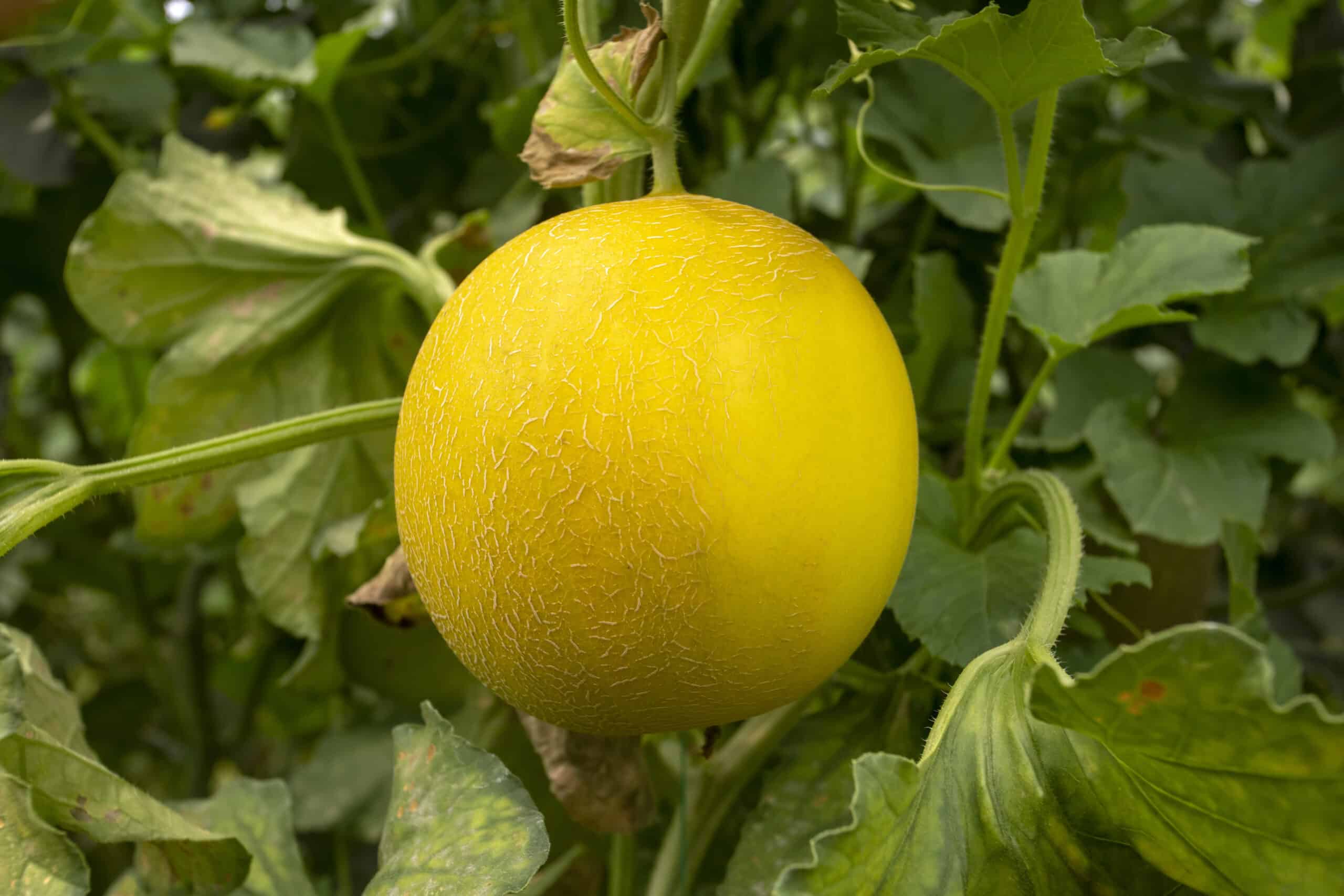
Watering melons
Keep melon plants evenly moist throughout the growing season. Do not let the soil dry out more than four inches below the surface. Water any time plants begin to wilt before noon.
Melons have deep taproots that seek out soil moisture. Direct watering will cool off and slow the growth of these heat-loving crops, so if irrigation is necessary where you live, water at the edge of growing hills or beds, not directly on or at the base of plants so as not to slow growth. Where irrigation is required and the weather is hot, give melon family crops 1 to 2 inches (2.5-5cm) of water each week.
- Melons require plentiful regular, and even watering for quick growth.
- Give melons 1 inch of water (16 gallons/60.5 liters) or more each week.
- Water with drip irrigation or a soaker hose to avoid wetting leaves. Wet leaves are susceptible to fungal diseases.
- Keep the soil around melons evenly moist from planting until the fruit begins to develop.
- You can cut back on watering once fruit begins to develop but don’t let the soil go dry. Less water will enhance sweetness.
- Dry soil a week before harvest will produce the sweetest melons.
- Avoid watering plants overhead which can result in mildew.
Melons require plentiful regular, and even watering for quick growth. Keep the soil moist until the fruit reaches full size then stop watering while the fruit ripens. Avoid watering plants overhead which can result in mildew.
Feeding melons
Feed melons with a side-dressing of compost tea or fish emulsion two weeks after seedlings appear or at transplanting time; feed melons again when the first flowers appear.
Prepare planting beds with aged compost; add aged manure to beds in the autumn before planting. Side dress melons with compost or manure tea every 2 to 3 weeks during the growing season.
- Prepare planting beds with aged compost; add aged manure to beds in the autumn before planting.
- Side dress melons with compost or manure tea every 2 to 3 weeks during the growing season.
- You can also feed melons a diluted solution of fish emulsion every 2 weeks.
- Flat, tasteless melons may suffer from a lack of magnesium or boron in the soil. Fruits can be sweetened by giving them a dose of Epsom salts and borax. For home garden use, use about 6½ tablespoons of Epsom salts and 3½ tablespoons of household borax added to five gallons of water. Spray-mist the vines with this solution.
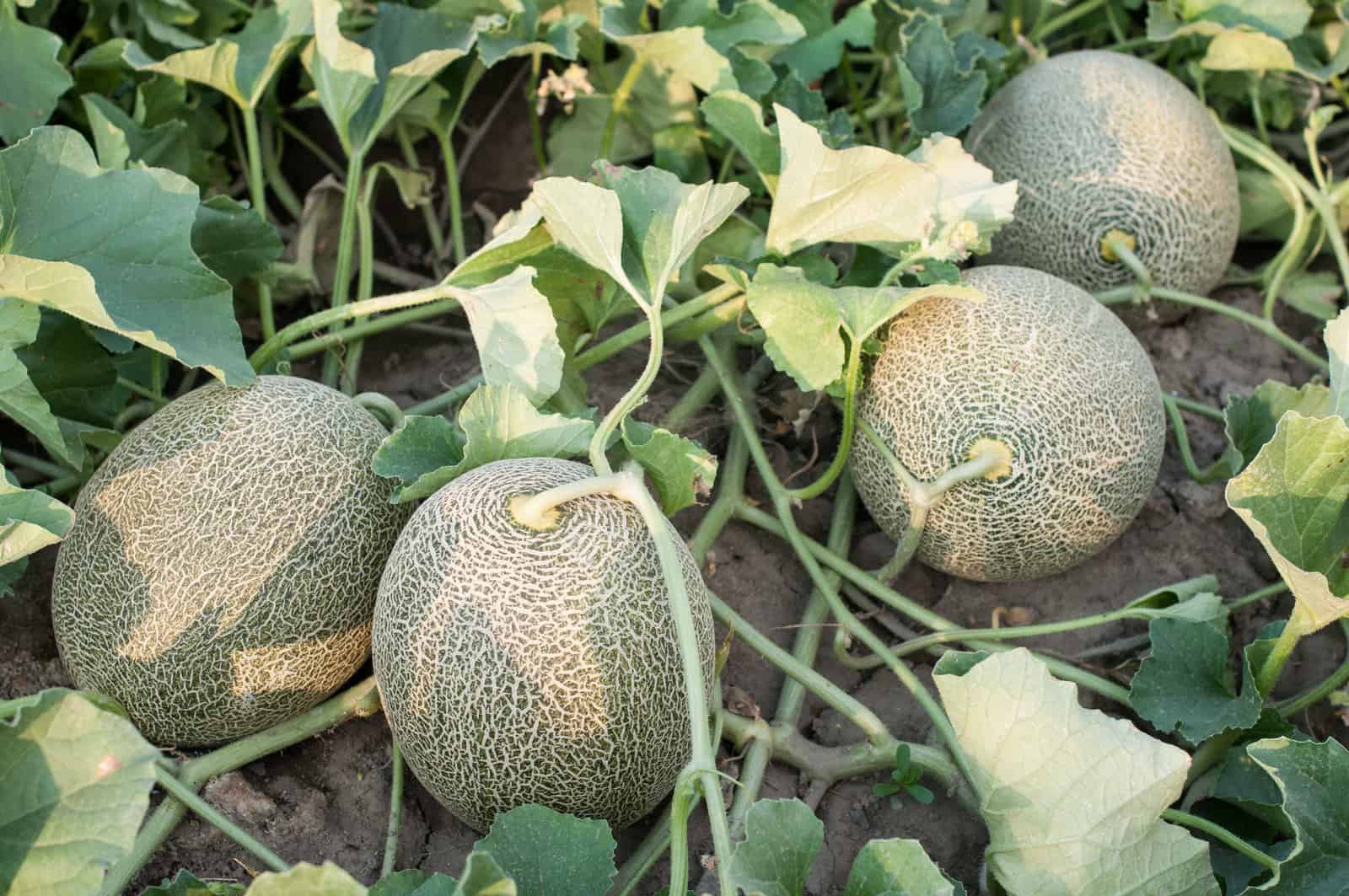
Caring for melons
When melons and squash begin to grow large, raise them off the soil and rest them on wooden shingles, clay roof tiles, sheets of plastic, or overturned cans to prevent contact with the soil and rotting.
Mulch to keep down weeds. Water to keep melons evenly moist; do not let the soil dry after transplanting or as fruits develop. Male flowers will appear first followed by female flowers. Give melons manure tea when the fruit sets and again about two weeks later. Don’t allow new flowers to develop after midsummer; let the plant concentrate its growing efforts on fruit that can mature before the end of warm weather.
- Cultivate carefully around vines until they cover the ground and smother out competing weeds.
- Mulch around melon plants with straw or dry, chopped leaves to retain soil moisture, slow weed growth, and keep fruits off of the soil.
- Support melons on a low tripod or A-frame trellis to keep them off the wet ground; use netting or a bag to support trellis- or fence-grown melons.
- Pinch back flowers to permit just 4 fruits to form on each vine. Fewer melons on a plant will be larger, sweeter, and come to harvest quicker.
- You can also pinch away some flowers so that a newly pollinated flower begins growing a new fruit every two weeks. This can stagger the harvest of fruit from one plant.
- For melons sprawling across the ground, place a shingle, tile, half milk jug, or clay pot under each melon to keep it dry and prevent rot. These items will also soak up solar heat and keep the fruit warm at night.
- Avoid pruning leaves off of plants until just before harvest. Leaves help produce the sugars melons need for sweetness. Pull back leaves that cover fruits to give fruits maximum sun exposure.
- Remove all new blossoms that appear within 50 days of the first frost in autumn. This will allow the plant to ripen fruit already on the vine before the first frost.
Melon pollination
- Melons produce male and female flowers on the same plant.
- Male flowers appear a week before female flowers. Female flowers have a small bulge (an unfertilized fruit) near the stem end of the blossom.
- Bees or other pollinators must carry pollen from male to female flowers for pollination, flowering, and fruit set to occur.
Melon pests
- Aphids and spotted and striped cucumber beetles will attack melons.
- Hose away aphids with a blast of water or pinch out infested foliage.
- Handpick and destroy cucumber beetles promptly; they can transmit cucumber bacterial wilt to melons. You can also dust or spray adult beetles with rotenone or a pyrethrum-based insecticide.
More tips: Melon Growing Problems: Troubleshooting.
Melon diseases
- Melons are susceptible to wilt, Alternaria leaf spot, stem blight, powdery and downy mildew, and root rot.
- Plant disease-resistant varieties.
- Keep the garden clean and free of weeds and plant debris that can harbor pests and diseases.
- Remove and destroy disease-infected plants immediately.
- Bacterial wilt is spread by cucumber beetles.
- Bacterial wilt and stem blight will cause melons to suddenly wilt and die.
- Control cucumber beetles as soon as they appear.
- Powdery mildew and downy mildew are fungal diseases that will cause melon leaves to turn gray-white late in the season. Protect leaves against fungal disease by spraying with compost tea or a solution of 1 part skim milk to 9 parts water.
- Select disease-resistant varieties.
- Improve air circulation by spacing plants properly.
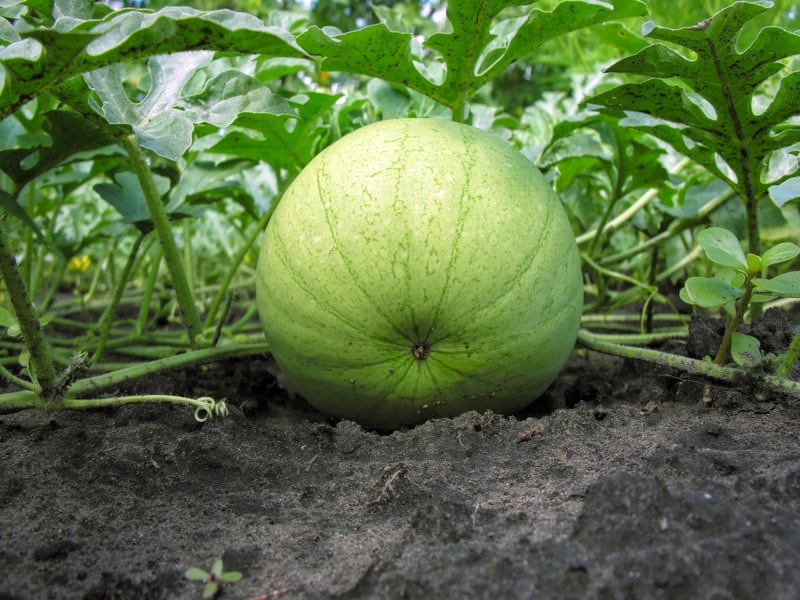
Harvesting melons
Melons are ready to harvest when they smell sweet and separate easily from the vine; watermelons are ready to pick when the underside of the fruit turns creamy yellow and the tendril at the stem end turns brown.
Muskmelons and cantaloupes that smell ripe are ripe. They should come away clean from the vine with little pressure. Thump watermelons to determine if it is ready for picking: a ripe watermelon will make a dull thump.
Cantaloupe, muskmelons, honeydews, and casaba melons require 70 to 140 days to reach maturity depending upon the variety. Nighttime air temperatures should not dip below 65°F (18°C) for the best growth and flavor.
Watermelons require 70 to 85 days from transplanting—which means about 110 days overall from seeding to ripe fruit. Watermelons that require the shortest season include Garden Baby (75 days) and Sugar Baby (80 days); these are among the smallest watermelons weighing in the 7 to the 10-pound range at maturity.
Winter melons will be ready for harvest 110 days after sowing. When melons reach full size and stems turn brown they are ready for harvest. Leave melons on the vine until they are ripe. Ripe melons will slip easily off the stem; a half-ripe melon will require more pressure and may come off with half the stem attached. Ripe melons will have a sweet aroma at the stem end. Limit water for a week in advance of the harvest to concentrate sweetness.
- Cantaloupes will be ready for harvest 70 to 100 days after sowing.
- Most melons on a single plant will come to harvest within a 3 to 4-week period.
- Limit water for a week in advance of the harvest to concentrate fruit sweetness. Too much water will dilute the sugars in the fruit.
- When muskmelons reach full-size rinds change from green to tan or yellow and stems turn brown they are ready for harvest. The skin under the netting will turn yellow-brown when the fruit is ripe and the netting will become more pronounced
- Smooth-skinned honeydew melons will become cream-colored when ripe.
- A ripe melon will develop a circular crack where the stem attaches to the fruit.
- Ripe melons will have a sweet aroma at the stem end.
- Ripe melons will slip easily off the stem; a half-ripe melon will require more pressure and may come off with half the stem attached.
- Harvest melons when they are dry.
- A ripe melon will soften after harvest but it will not continue to sweet off the vine.
- Leave melons on the vine until they are ripe.
More tips: How to Harvest and Store Melons.
Storing and preserving melons
- Melons will keep in the refrigerator for up to one week, but sweetness and flavor may diminish.
- Melon slices or balls can be frozen or pickled.
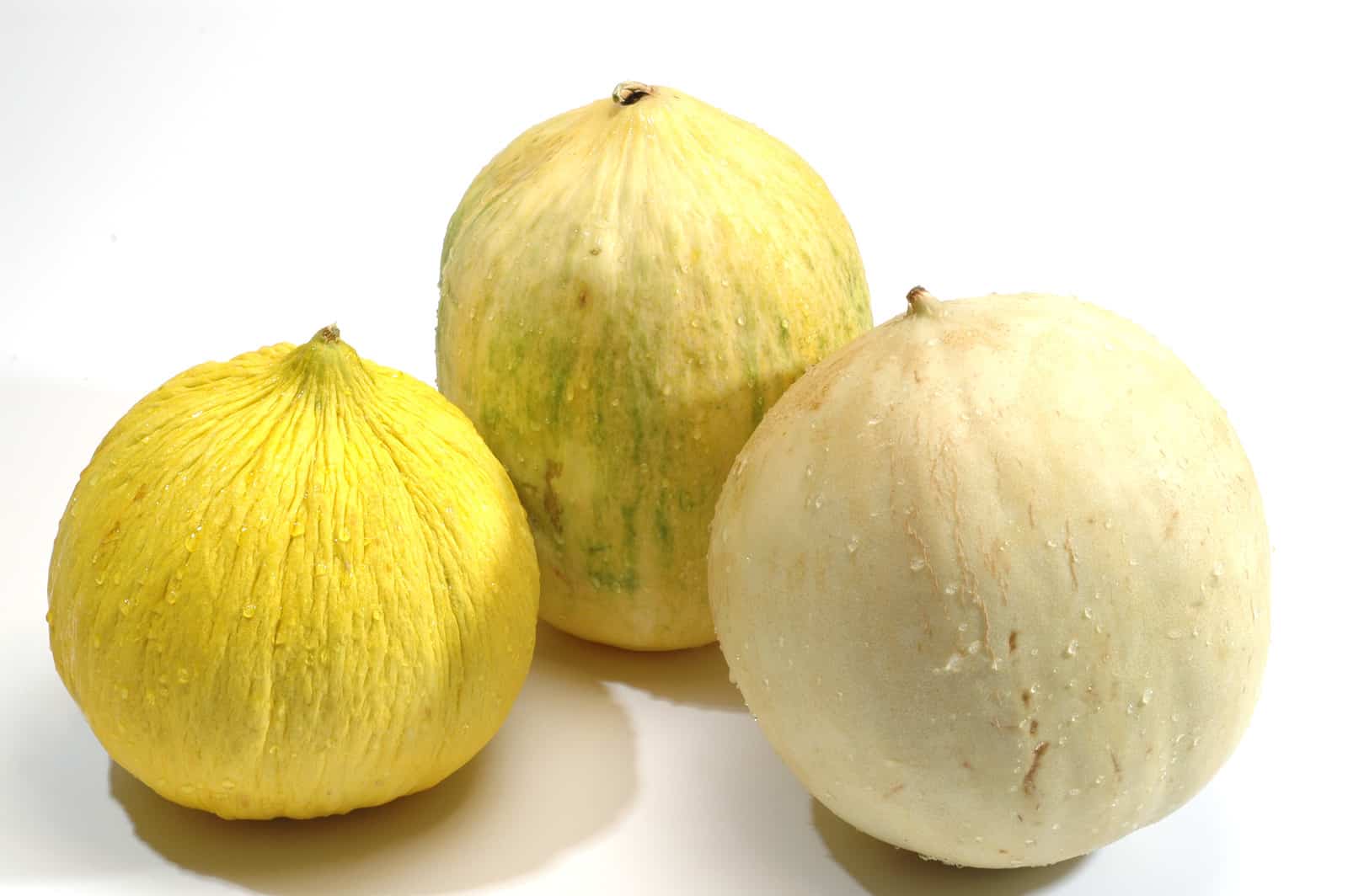
Melon varieties to grow
Muskmelons and cantaloupes are known as summer melons.
Casabas, Crenshaws, and honeydews are called winter melons because they come to harvest later than most muskmelons and cantaloupes. Winter melons come to harvest at the end of summer (not in winter).
Here are some flavorful best bet, easy-to-grow melons–both summer and winter melons (added days to maturity)–divided into four categories: orange-fleshed melons; green-fleshed melons; honeydew types; and others.
Orange-fleshed melons
- Ambrosia. 86 days. Very sweet, juicy, and distinctive flavor. Uniform, medium-sized, nearly round fruit 6 inches in diameter, heavily netted, weighs 4½ to 5. Salmon flesh, thick rind; seed cavity small with a tight mass of seeds. Prolific vines. Downy mildew and powdery mildew resistant. Hybrid.
- Burpee Hybrid. 82 days. Sweet, flavorful, firm, and juicy, excellent quality. Round to slight oval fruit, 6 inches in diameter, heavily netted, distinctly ribbed, weighs 4 to 4½ pounds; deep-orange flesh, thick rind. High-yielding vine; produces well in northern regions. Popular with home gardeners. Hybrid.
- Bush Star. 88 days. Big, sweet flavor fresh or frozen. Bush plant with fruit to 2 pounds; salmon flesh. Very good yields in small gardens. All-American Selection; Fusarium wilt resistant. Hybrid.
- Earlisweet. 68 days. Sweet flavor. Medium netted slightly ribbed fruit to 5½ pounds; deep salmon flesh. Early variety; high yielding. Fusarium tolerant. Hybrid.
- Gold Star. 86 days. Flavorful, fragrant. Oval fruit with deep netting weighs 3 to 4 pounds. Hybrid.
- Harper Hybrid. 86 days. Sweet, tangy flavor, rich aroma. Medium-size, round, finely netted fruit; honeydew-muskmelon parentage; firm, thick salmon flesh. Vigorous prolific grower. Hybrid.
- Harvest Queen. 89-95 days. Shipping melon keeps 5 to 6 days, heavily netted, faintly ribbed, 6 inches in diameter, weight 3 to 4 pounds; firm, thick deep-orange flesh, small seed. Fusarium wilt resistant. Open-pollinated.
- Iroquois. 87 days. Sweet flavor, fragrant. Oval to nearly round, grayish-green rind, netted with ribs, 6½ inches in diameter, weighs 4 to 6 pounds; deep orange, fine-textured flesh. Fusarium wilt resistant. Good in cooler regions. Heirloom. Open-pollinated.
- Pulsar. 80 days. Sweet flavor. Medium-size round, heavily netted 5 to 5½ pounds; thick, firm orange flesh. Tolerant of powdery mildew and fusarium wilt. Good in cool regions. Hybrid.
- Saticoy Hybrid. 80-90 days. Rich, sweet flavor. Oval, lightly netted fruit, about 4 pounds; deep-orange flesh. Strong vines. Fusarium wilt, anthracnose, and powdery mildew resistant.
- Superstar. 86 days. Great flavor, aromatic. Large, round fruit, 6 to 8 pounds, coarse netting; smooth, thick salmon-colored flesh. Good in eastern and Midwest gardens. Hybrid.
Green-fleshed melons
- Galia. 65 days. Very sweet, and aromatic. Large, round fruit weighs 2 to 2½ pounds, heavily netted; yellow rind, light green flesh, small seed cavity. Vigorous grower; grows well in frames or open garden. Powdery mildew resistant. Hybrid.
- Jenny Lind. 75 days. Sweet, mild-flavored, juicy; lacks aroma. Small fruit, flattened at both ends with a small knob on the blossom end, 5 to 6 inches in diameter, weighs 1½ to 2 pounds; dull brownish-orange rind mottled with green; light green flesh. Introduced in 1846. Open-pollinated.
- Passport. 73 days. Large, 6 to 7 inches in diameter; dark green skin; thick dark green flesh becomes whitish green in the center. Vigorous vines tolerate anthracnose and gummy stem blight. Hybrid
- Rocky Sweet. 85 days. Sweet, and delicious with no musky flavor. Medium size round fruit weighs 3 to 4 pounds, moderately netted, with light sutures; dark green rind turning yellow then yellow-orange when ripe; thick lime-green flesh. Vigorous and prolific vines. Hybrid.
Honeydew-type melons
- Honeydew. 95-115 days. Sweet, juicy. Broad oval fruit 7 to 8 inches, 7 inches in diameter, weighs about 6 pounds average; smooth ivory skin, no netting; light-green very sweet juicy flesh, small seed cavity, hard rind, prefers warm dry climates, good storage. Fusarium wilt resistant. Hybrid.
- Early Dew. 80 days. Sweet, tender. Nearly round fruit 5 to 6 inches in diameter, weighs 2½ to 3 pounds; smooth green-gold rind at full maturity; lime-green flesh. Vigorous vine grows well in short-season regions. Excellent for home gardens. Fusarium wilt resistant. Hybrid,
- Honey Brew. 90 days. Concentrated sweetness. Smooth, thick pale green skin; tender, green flesh. High yield; strong disease resistance. Hybrid.
- Morning Dew. 96 days. Very sweet. Large, oblong fruit, weighs 10 to 12 pounds; thick, green flesh. Vigorous vine; Fusarium wilt, powdery mildew, and downy mildew resistant. Long season. Hybrid
- Tam Dew. 95-100 days. Sweet, juicy. Medium-large, oval fruit 6 inches in diameter, weighs 5 to 6½ pounds; smooth, creamy white rind; thick light-green flesh, small seed cavity. Downy mildew and powdery mildew resistant. Open-pollinated.
- Venus. 88 days. Juicy, sweet, aromatic. Medium-size oval fruit, 5½ inches in diameter; light golden-yellow, slightly netted rind; bright green flesh. Heavy yield. Hybrid.
Other melons varieties
- Casaba Golden Beauty. 110 days. Spicy sweet flavor, aromatic. Oval to round fruit with golden-yellow wrinkled skin, 7 to 8 pounds; white flesh. Good to store. Grows well in hot regions. Open-pollinated.
- Crenshaw. 90-115 days. Sweet distinctive flavor, juicy. Oval fruit slightly tapered toward the stem end, pear shape; 6 to 6½ inches in diameter, 8 to 10 inches long, weighs 6 to 10 pounds; salmon-pink flesh. Requires a long, warm season. Vigorous productive plants. Open-pollinated.
- Honeyshaw. 85 days. Sweet. Crenshaw hybrid, 7 to 10 inches elongated, yellow, corrugated skin; salmon-pink flesh. Early to mature. Hybrid.
- Marygold. 88-92. Very sweet. Small Casaba type, bright yellow wrinkled skin, weighs 3½ pounds; green to white flesh. A good grower in warm, humid regions. Very good yield. Disease resistance. Hybrid.
Muskmelon (cantaloupe) varieties
A muskmelon is round with a yellow-tan netted rind. A muskmelon has salmon, white, or green flesh and weighs 2 to 3 pounds (.9-1.3 kg). Muskmelons are very sweet to taste and have aromatically perfumed flesh
A true cantaloupe is oval or globe-shaped with a hard, rough, scaled, or warted-rind (not a netted skin). The flesh can be gray-green, yellow-tan and orange, or salmon-orange. A true cantaloupe weighs about 2 pounds (.9 kg). It is sweet-tasting and aromatic
The muskmelon or cantaloupe is a long-trailing annual plant.
- Early Season: ‘Alaska’ (65-80 days); ‘Canada Gem’ (78 days); ‘Earligold’ (73 days); ‘Early Hanover’ (80 days); ‘Magnum’ (80 days); ‘Primo’ (79 days); ‘Pronto’ (80 days); ‘Pulsar’ (80 days); ‘Solid Gold’ (80 days); ‘Sweet Granite’ (80 days); ‘Sweet ‘N Early’ (75 days).
- Midseason: ‘Ambrosia’ (86 days); ‘Delicious’ (83 days); ‘Edisto’ (88 days); ‘Four-Fifty’ (90 days); ‘Grande Gold’ (88 days); ‘Hale’s Best’ (86 days); ‘Imperial’ (90 days); ‘Pike’ (85 days); ‘Pulsar’ (86 days); ‘Roadside’ (90 days); ‘Super Market’ (90 days); ‘Superstar’ (86 days).
- Late Season: ‘Edisto’ (95 days); ‘Hearts of Gold’ (95 days); ‘Iroquois’ (90 days); ‘Kansas’ (90 days); ‘Saticoy’ (90 days); ‘Top Mark’ (90 days).
- Large: ‘Old Time Tennessee’ (90 days).
- Space Savers: ‘Bush Star’ (80 days); ‘Jenny Lind’ (75 days).
Winter melon varieties
Winter melons come in a variety of sizes, shapes, and colors. These melons are long trailing annuals.
- Casaba: round or ovoid with wrinkled, rough yellow-rind and greenish-whitish flesh weighing about 5 pounds (2.2 kg). Greenish tinge at the stem end. Smooth-textured, creamy flesh is juicy and subtly sweet, and less fragrant than other melons.
- Charental: elongated, globe-shaped melon with smooth to slightly netted grey-green rind with slight ridges and a firm deep orange, sweet flesh.
- Crenshaw: smooth yellow-green skin with pale green or salmon flesh weighing about 6 pounds (2.7 kg). A hybrid cross between the casaba and cantaloupe. The flesh is extra sweet and juicy with a sweet spicy aroma. Softer than other melons.
- Honeydew: more ovoid than round with smooth rind that changes from pale green to creamy yellow as it ripens weighing about 3 pounds (1.3 kg); green, white, orange, or pink-orange flesh.
- Persian: large, oval-to-round, strongly netted, unridged rind with a musky orange-colored flesh; similar to a cantaloupe, but larger, weighing 7 to 8 pounds (3.1-3.6kg)..
About melons
- Botanical name: Cucumis melo
- Family: Cucurbitaceae — Cucurbits or gourd family
- Origin: South Asia, tropical Africa
Melon articles at Harvest to Table:
How to Plant and Grow Watermelon
How to Harvest and Store Melons
How to Harvest and Store Watermelon
Melons Growing Problems Troubleshooting
Serve Watermelon With These Flavor Matches
More how to grow articles:
Learn how to plant, grow, and harvest your favorite vegetables. Click below for all you need to know.
- Artichoke
- Arugula
- Asparagus
- Beans, Snap
- Beets
- Broad Beans
- Broccoli
- Brussels Sprouts
- Cabbage
- Cantaloupe — Melons
- Cardoon
- Carrots
- Cauliflower
- Celeriac
- Celery
- Chard
- Chayote Squash
- Chickpeas
- Chicory
- Chinese Cabbage
- Collards
- Corn Salad
- Corn, Sweet
- Cresses
- Cucumbers
- Eggplant
- Endive and Escarole
- Fava Beans
- Florence Fennel
- Garbanzo Beans
- Garlic
- Horseradish
- Jerusalem Artichoke
- Kale
- Kohlrabi
- Leeks
- Lettuce
- Lima Beans
- Melons
- Mizuna
- Mustard Greens
- New Zealand Spinach
- Okra
- Onions
- Parsnips
- Peanuts
- Peas
- Peppers
- Potatoes
- Pumpkins
- Radicchio
- Radishes
- Rhubarb
- Rutabaga
- Salsify
- Shallots
- Sorrel
- Southern Peas
- Soybeans
- Spinach
- Squash, Summer
- Squash, Winter
- Sunchokes
- Sweet Potato
- Swiss Chard
- Taro
- Tomatillo
- Tomatoes
- Turnips
- Watermelon
- Zucchini















